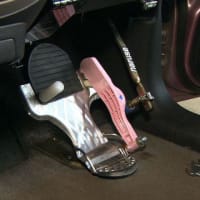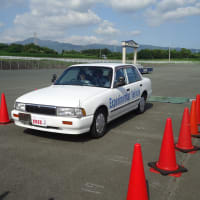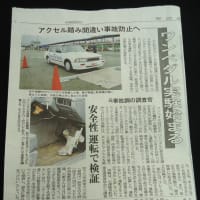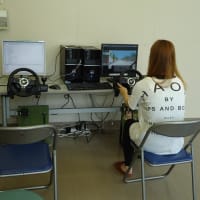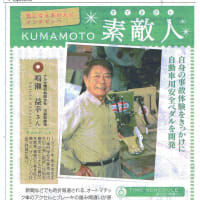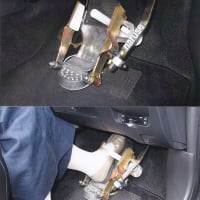ガスとブレーキ(2)ペダルは、改善のリコールをつくった
ニューヨークタイムズ
玉名(日本)の彼の工場のマスユキナルセ(右)。
田淵弘子によって発表しました:2010年8月3日
特にストレスの下で、並んでいるペダル装置は、誤ってドライバーにブレーキの代わりにアクセラレータに床を張らせることがありえると、発明者が言います。解決?足の側で困っているとき、車を加速する一つのペダル。適切により多くで、ペダルが押し下げられるとき、それは常にブレーキを動かします。
「我々がうろたえるとき、我々には下にずかずか歩く自然の傾向があります」と、発明者(マスユキナルセ)が言いました。そして、その人はここ南西日本で小さな工場を所有します。「自動車メーカーは、それをドライバーエラーと呼びます。しかし、彼らのデザインがすべての誤りであるならば、どうですか?」、ナルセ氏(74)は予想外の加速に起因する事故を防ぐ努力において複合ブレーキ-アクセルを設計した少数の人々のうちの1人です。そして、それは若干のトヨタ車両が警告なしで速める告訴からスポットライトを受けました。
スウェーデンの監査機関は、発明者スベングスタファソンによって一つのペダルプロトタイプをテストしています。日本では、ナルセ氏のペダル(大部分は友人と知人によって所有される)を備えているおよそ130台の車は通り合法的であると宣言されました。そして、ナルセ氏の自身の三菱ディアマンテセダンを含みました。彼は、日本、アメリカ合衆国と6つの他の国でナルセ(はっきりしたNAH-roo-say)Pedalの特許を持ちます。
ヤストオハマ(トヨタHarrierがペダルのうちの1つを持っているセキュリティ会社役員)は、彼の足がブレーキの代わりにガスを打ったあと、彼が変わった、そして、彼がほとんど自転車乗りをたたいたと言いました。
「私は、決して戻ることができません」と、オハマ氏が言いました。「1つのペダルだけがあるとき誤ることがないので、私には現在心の平和があります。」、トヨタ(それは予想外の加速の報告を動かなくなるか、床マットの下で捕えられるアクセルペダルのものであると考えます)は問題に対処するために、世界中で850万台の車両をリコールしました。それは、場合によっては、ドライバーが誤っていたかもしれないことをも穏やかに示唆しました。
先月、ドライバーがブレーキの代わりに誤ってアクセラレータを押して、それは意図せずに加速したと報告される2,000台の車両の内部調査がほとんどの場合「足誤用」を見つけると言いました。
リリコタケウチ(トヨタの東京に基づく代者)は、同社がナルセ氏の足デザインについてコメントすることができないと言いました。彼女がトヨタを言ったが、「我々が改善のための場所が常にあると思っているので、我々が市民から受け取る考えを聞きます。」、「あなたが現在の足デザインが我々がすることができる最高であるかどうか尋ねるならば、答えはいいえです」と、タケウチさんが言いました。
ナルセ氏のペダルは、いろいろなバージョンで、20年の間方々を見ています。しかし、最近までは、彼の証拠は、聞こえない耳の上で大部分は落ちました — 多くにもかかわらず、事故は足混乱とつながりました。
2009年に、37の死と9,500以上の怪我を含んでいるほぼ6,700の交通事故はブレーキの代わりに誤ってアクセラレータを押している日本でドライバーに起因したと考えられました ― Traffic Accident ResearchとData Analysis研究所が言った ― 政府は東京に拠点を置くグループを合併しました。
自動車安全性スペシャリストは、アメリカ合衆国での何万もの事故が足エラーにも起因したことがありそうであると言います。2003年のサンタモニカ(カリフォルニア)での事故では、彼の車が屋外の市場に飛び込んだとき、間違ったペダルを打ったと思われているドライバーは10人を殺しました。
少なくとも1980年代から、研究者はドライバーがブレーキの代わりにアクセラレータを押す傾向を指さしました。1989年の研究において、リチャードA・シュミット(現在カリフォルニア大学ロサンゼルス校の心理学者)は運動支配プロセスへの混乱がどのように足が意図された運動からそれる原因になることがありえるかについて述べました。そして、ブレーキからアクセラレータにすべり落ちさえしました。そして、車が予想外に加速するとき ― シュミット氏が言った ― 経験豊かなドライバーさえうろたえることができます。そして、より激しく「ブレーキをかけさえします」。
福岡市の九州産業大学の松永勝也、エンジニアリングと心理学スペシャリストによる日本の実験では、驚くべき音を伴う間、ドライバーはちょうどいい時にアクセラレータからブレーキまで足を変えるよう頼まれて、時間状態にありました。ストレスの下の主題は時々躊躇したか、1つのペダルから他へ切り替えることが難しいとわかったと、彼が言いました。
現在の標準的なペダル装置は、自動車進化の機能です。
フォードの1908台のT型のドライバーは、ステアリングコラムと3つのペダルの上でアクセラレータレバーを動かしました:ギアを移すために、バックして、ブレーキをかけます。時間とともに、いろいろなマニュアルと自動変速装置の出現は、異なるフットワークを必要としました。
Gas-and-Brake Pedal Gets New Look After Recalls
Tyler Sipe for The New York Times
Masuyuki Naruse, right, in his factory in Tamana, Japan.
By HIROKO TABUCHI
Published: August 3, 2010
The side-by-side pedal arrangement, the inventor says, can cause drivers mistakenly to floor the accelerator instead of the brakes, especially under stress. The solution? A single pedal that accelerates the car when pressed with the side of the foot. More to the point, when the pedal is pushed down, it always activates the brakes.
“We have a natural tendency to stomp down when we panic,” said the inventor, Masuyuki Naruse, who owns a small factory here in southwest Japan. “The automakers call it driver error. But what if their design’s all wrong?”
Mr. Naruse, 74, is one of a handful of people who have designed combined brake-accelerator pedals in an effort to prevent accidents caused by unintended acceleration, which has come under a spotlight since charges that some Toyota vehicles accelerate without warning.
Regulators in Sweden are testing a single-pedal prototype by the inventor Sven Gustafsson. In Japan, about 130 cars equipped with Mr. Naruse’s pedal, mostly owned by friends and acquaintances, have been declared street-legal, including Mr. Naruse’s own Mitsubishi Diamante sedan. He holds patents for the Naruse (pronounced NAH-roo-say) Pedal in Japan, the United States and six other countries.
Yasuto Ohama, a security company executive whose Toyota Harrier has one of the pedals, said he switched after his foot hit the gas instead of the brakes and he almost struck a bicyclist.
“I can never go back,” Mr. Ohama said. “I now have peace of mind, because there’s no mistaking when there’s only one pedal.”
Toyota, which attributes reports of unintended acceleration to gas pedals that stick or get caught under floor mats, has recalled 8.5 million vehicles worldwide to address the problems. It has also gently suggested that in some cases the driver might have been at fault.
Last month, it said that an internal investigation of 2,000 vehicles reported to have accelerated unintentionally found “pedal misapplication” in most cases, with drivers mistakenly pressing the accelerator instead of the brakes.
Ririko Takeuchi, a Tokyo-based spokeswoman for Toyota, said the company could not comment on Mr. Naruse’s pedal design. But she said Toyota “listens to ideas we receive from the public, because we believe there’s always room for improvement.”
“If you ask whether the current pedal design is the best we can do, the answer is no,” Ms. Takeuchi said.
Mr. Naruse’s pedal, in various versions, has been around for two decades. But until recently his testimonials fell mostly on deaf ears — despite many accidents linked to pedal confusion.
In 2009, nearly 6,700 traffic accidents involving 37 deaths and more than 9,500 injuries were thought to have been caused by drivers in Japan mistakenly pushing the accelerator instead of the brakes, said the Institute for Traffic Accident Research and Data Analysis, a government affiliated group based in Tokyo.
Car safety specialists say it is likely that tens of thousands of crashes in the United States have also been caused by pedal errors. In an accident in Santa Monica, Calif., in 2003, a driver believed to have hit the wrong pedal killed 10 people when his car plunged into an outdoor market.
Since at least the 1980s, researchers have pointed to the propensity for drivers to press the accelerator instead of the brakes. In a 1989 study, Richard A. Schmidt, a psychologist now at the University of California, Los Angeles, described how disruptions to neuromuscular processes can cause the foot to deviate from the intended motion, even slipping from the brake to the accelerator. And when the car accelerates unexpectedly, Mr. Schmidt said, even experienced drivers can panic, “braking” even harder.
In experiments in Japan by Katsuya Matsunaga, an engineering and psychology specialist at Kyushu Sangyo University in Fukuoka City, drivers were asked to switch feet from the accelerator to the brakes on cue, at times while accompanied by startling noises. Subjects under stress sometimes hesitated or found it difficult to switch from one pedal to the other, he said.
The current standard pedal arrangement is a function of automotive evolution.
Drivers of Ford’s 1908 Model T maneuvered an accelerator lever on the steering column and three pedals: for shifting gears, reversing and braking. Over time, the advent of various manual and automatic transmissions has required different footwork.
ニューヨークタイムズ
玉名(日本)の彼の工場のマスユキナルセ(右)。
田淵弘子によって発表しました:2010年8月3日
特にストレスの下で、並んでいるペダル装置は、誤ってドライバーにブレーキの代わりにアクセラレータに床を張らせることがありえると、発明者が言います。解決?足の側で困っているとき、車を加速する一つのペダル。適切により多くで、ペダルが押し下げられるとき、それは常にブレーキを動かします。
「我々がうろたえるとき、我々には下にずかずか歩く自然の傾向があります」と、発明者(マスユキナルセ)が言いました。そして、その人はここ南西日本で小さな工場を所有します。「自動車メーカーは、それをドライバーエラーと呼びます。しかし、彼らのデザインがすべての誤りであるならば、どうですか?」、ナルセ氏(74)は予想外の加速に起因する事故を防ぐ努力において複合ブレーキ-アクセルを設計した少数の人々のうちの1人です。そして、それは若干のトヨタ車両が警告なしで速める告訴からスポットライトを受けました。
スウェーデンの監査機関は、発明者スベングスタファソンによって一つのペダルプロトタイプをテストしています。日本では、ナルセ氏のペダル(大部分は友人と知人によって所有される)を備えているおよそ130台の車は通り合法的であると宣言されました。そして、ナルセ氏の自身の三菱ディアマンテセダンを含みました。彼は、日本、アメリカ合衆国と6つの他の国でナルセ(はっきりしたNAH-roo-say)Pedalの特許を持ちます。
ヤストオハマ(トヨタHarrierがペダルのうちの1つを持っているセキュリティ会社役員)は、彼の足がブレーキの代わりにガスを打ったあと、彼が変わった、そして、彼がほとんど自転車乗りをたたいたと言いました。
「私は、決して戻ることができません」と、オハマ氏が言いました。「1つのペダルだけがあるとき誤ることがないので、私には現在心の平和があります。」、トヨタ(それは予想外の加速の報告を動かなくなるか、床マットの下で捕えられるアクセルペダルのものであると考えます)は問題に対処するために、世界中で850万台の車両をリコールしました。それは、場合によっては、ドライバーが誤っていたかもしれないことをも穏やかに示唆しました。
先月、ドライバーがブレーキの代わりに誤ってアクセラレータを押して、それは意図せずに加速したと報告される2,000台の車両の内部調査がほとんどの場合「足誤用」を見つけると言いました。
リリコタケウチ(トヨタの東京に基づく代者)は、同社がナルセ氏の足デザインについてコメントすることができないと言いました。彼女がトヨタを言ったが、「我々が改善のための場所が常にあると思っているので、我々が市民から受け取る考えを聞きます。」、「あなたが現在の足デザインが我々がすることができる最高であるかどうか尋ねるならば、答えはいいえです」と、タケウチさんが言いました。
ナルセ氏のペダルは、いろいろなバージョンで、20年の間方々を見ています。しかし、最近までは、彼の証拠は、聞こえない耳の上で大部分は落ちました — 多くにもかかわらず、事故は足混乱とつながりました。
2009年に、37の死と9,500以上の怪我を含んでいるほぼ6,700の交通事故はブレーキの代わりに誤ってアクセラレータを押している日本でドライバーに起因したと考えられました ― Traffic Accident ResearchとData Analysis研究所が言った ― 政府は東京に拠点を置くグループを合併しました。
自動車安全性スペシャリストは、アメリカ合衆国での何万もの事故が足エラーにも起因したことがありそうであると言います。2003年のサンタモニカ(カリフォルニア)での事故では、彼の車が屋外の市場に飛び込んだとき、間違ったペダルを打ったと思われているドライバーは10人を殺しました。
少なくとも1980年代から、研究者はドライバーがブレーキの代わりにアクセラレータを押す傾向を指さしました。1989年の研究において、リチャードA・シュミット(現在カリフォルニア大学ロサンゼルス校の心理学者)は運動支配プロセスへの混乱がどのように足が意図された運動からそれる原因になることがありえるかについて述べました。そして、ブレーキからアクセラレータにすべり落ちさえしました。そして、車が予想外に加速するとき ― シュミット氏が言った ― 経験豊かなドライバーさえうろたえることができます。そして、より激しく「ブレーキをかけさえします」。
福岡市の九州産業大学の松永勝也、エンジニアリングと心理学スペシャリストによる日本の実験では、驚くべき音を伴う間、ドライバーはちょうどいい時にアクセラレータからブレーキまで足を変えるよう頼まれて、時間状態にありました。ストレスの下の主題は時々躊躇したか、1つのペダルから他へ切り替えることが難しいとわかったと、彼が言いました。
現在の標準的なペダル装置は、自動車進化の機能です。
フォードの1908台のT型のドライバーは、ステアリングコラムと3つのペダルの上でアクセラレータレバーを動かしました:ギアを移すために、バックして、ブレーキをかけます。時間とともに、いろいろなマニュアルと自動変速装置の出現は、異なるフットワークを必要としました。
Gas-and-Brake Pedal Gets New Look After Recalls
Tyler Sipe for The New York Times
Masuyuki Naruse, right, in his factory in Tamana, Japan.
By HIROKO TABUCHI
Published: August 3, 2010
The side-by-side pedal arrangement, the inventor says, can cause drivers mistakenly to floor the accelerator instead of the brakes, especially under stress. The solution? A single pedal that accelerates the car when pressed with the side of the foot. More to the point, when the pedal is pushed down, it always activates the brakes.
“We have a natural tendency to stomp down when we panic,” said the inventor, Masuyuki Naruse, who owns a small factory here in southwest Japan. “The automakers call it driver error. But what if their design’s all wrong?”
Mr. Naruse, 74, is one of a handful of people who have designed combined brake-accelerator pedals in an effort to prevent accidents caused by unintended acceleration, which has come under a spotlight since charges that some Toyota vehicles accelerate without warning.
Regulators in Sweden are testing a single-pedal prototype by the inventor Sven Gustafsson. In Japan, about 130 cars equipped with Mr. Naruse’s pedal, mostly owned by friends and acquaintances, have been declared street-legal, including Mr. Naruse’s own Mitsubishi Diamante sedan. He holds patents for the Naruse (pronounced NAH-roo-say) Pedal in Japan, the United States and six other countries.
Yasuto Ohama, a security company executive whose Toyota Harrier has one of the pedals, said he switched after his foot hit the gas instead of the brakes and he almost struck a bicyclist.
“I can never go back,” Mr. Ohama said. “I now have peace of mind, because there’s no mistaking when there’s only one pedal.”
Toyota, which attributes reports of unintended acceleration to gas pedals that stick or get caught under floor mats, has recalled 8.5 million vehicles worldwide to address the problems. It has also gently suggested that in some cases the driver might have been at fault.
Last month, it said that an internal investigation of 2,000 vehicles reported to have accelerated unintentionally found “pedal misapplication” in most cases, with drivers mistakenly pressing the accelerator instead of the brakes.
Ririko Takeuchi, a Tokyo-based spokeswoman for Toyota, said the company could not comment on Mr. Naruse’s pedal design. But she said Toyota “listens to ideas we receive from the public, because we believe there’s always room for improvement.”
“If you ask whether the current pedal design is the best we can do, the answer is no,” Ms. Takeuchi said.
Mr. Naruse’s pedal, in various versions, has been around for two decades. But until recently his testimonials fell mostly on deaf ears — despite many accidents linked to pedal confusion.
In 2009, nearly 6,700 traffic accidents involving 37 deaths and more than 9,500 injuries were thought to have been caused by drivers in Japan mistakenly pushing the accelerator instead of the brakes, said the Institute for Traffic Accident Research and Data Analysis, a government affiliated group based in Tokyo.
Car safety specialists say it is likely that tens of thousands of crashes in the United States have also been caused by pedal errors. In an accident in Santa Monica, Calif., in 2003, a driver believed to have hit the wrong pedal killed 10 people when his car plunged into an outdoor market.
Since at least the 1980s, researchers have pointed to the propensity for drivers to press the accelerator instead of the brakes. In a 1989 study, Richard A. Schmidt, a psychologist now at the University of California, Los Angeles, described how disruptions to neuromuscular processes can cause the foot to deviate from the intended motion, even slipping from the brake to the accelerator. And when the car accelerates unexpectedly, Mr. Schmidt said, even experienced drivers can panic, “braking” even harder.
In experiments in Japan by Katsuya Matsunaga, an engineering and psychology specialist at Kyushu Sangyo University in Fukuoka City, drivers were asked to switch feet from the accelerator to the brakes on cue, at times while accompanied by startling noises. Subjects under stress sometimes hesitated or found it difficult to switch from one pedal to the other, he said.
The current standard pedal arrangement is a function of automotive evolution.
Drivers of Ford’s 1908 Model T maneuvered an accelerator lever on the steering column and three pedals: for shifting gears, reversing and braking. Over time, the advent of various manual and automatic transmissions has required different footwork.











